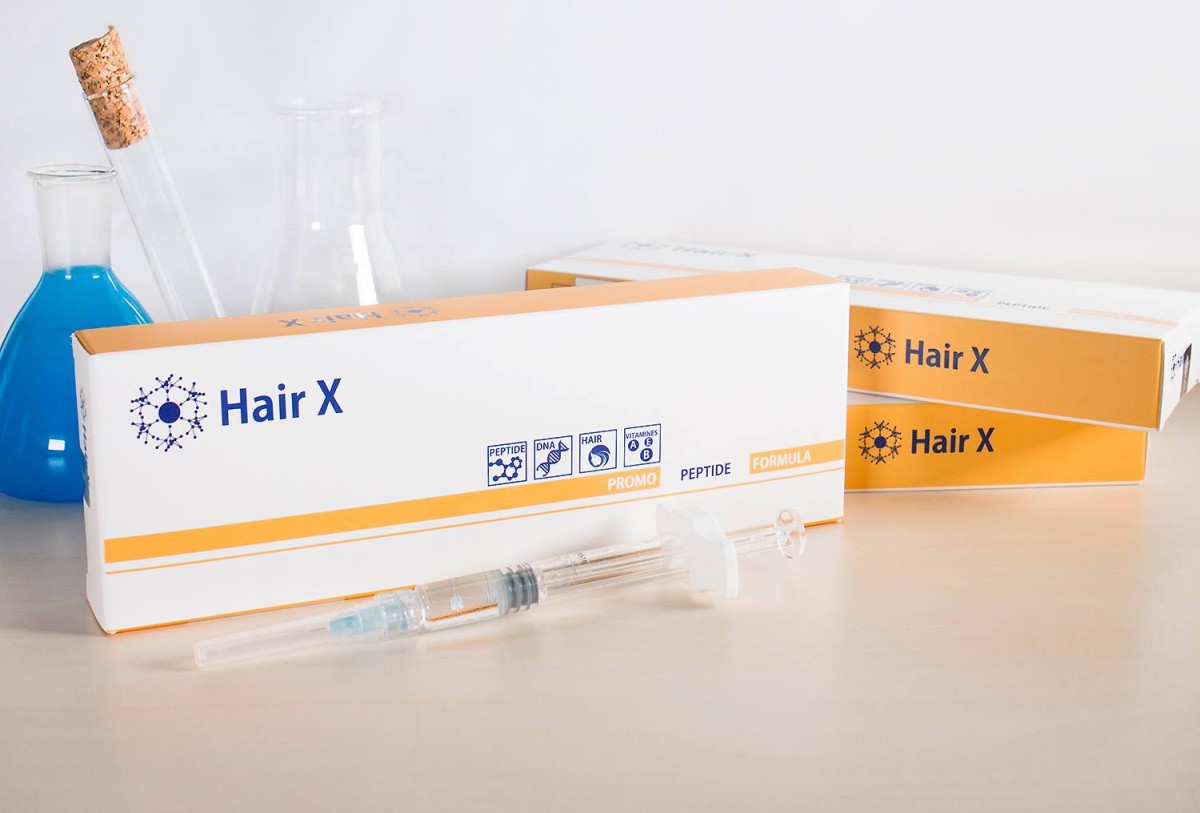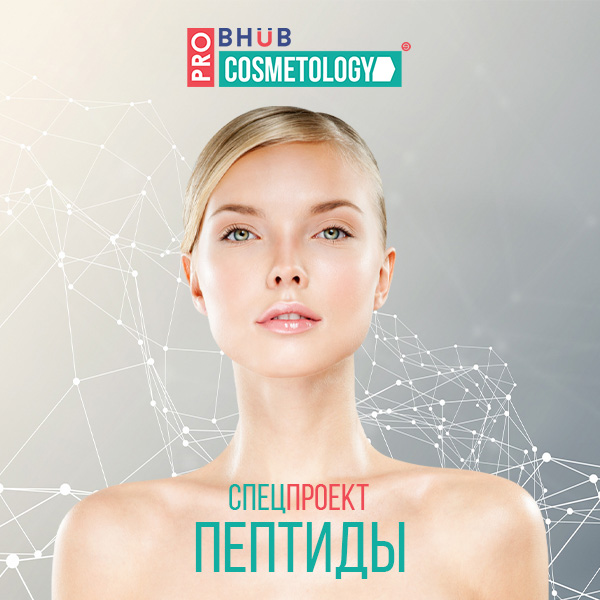Biomimetic peptides: possibilities in the treatment of alopecia
What issues and problems can be solved?

Among the ingredients, a special place is occupied by peptides - substances that can act at the cellular and even molecular level, regulating various physiological processes in the skin and scalp.
As is often the case with fashionable ingredients, peptides , on the one hand, are shrouded in legends generated by the imagination of the authors of advertising texts, and on the other hand, their true capabilities often remain hidden from specialists due to the fact that not everyone understands the principles of operation of peptide drugs . And this is not surprising, because the concepts that formed the basis for the creation of peptide cosmetology were developed quite recently, and even scientists who work in this field consider them complex. Therefore, many people treat peptides as a passing fashion trend that is about to give way to new sensations. Meanwhile, it is peptide cosmetics that is now the direction that opens up the most impressive prospects in the fight against wrinkles and other aesthetic problems of the skin and hair.
One of the current trends in injection cosmetology is the use of drugs that contain biomimetic peptides.
Peptides are substances whose molecules are built from two or more amino acid residues connected into a chain by peptide (amide) bonds. The uniqueness of their action lies in receptor regulation; despite their high biological activity, peptides are selective compounds that interact only with receptors on the cell membrane, without exhibiting a systemic effect.
Mesotherapy cocktails containing peptide complexes are highly effective. What issues and problems can be solved?
1. Oily and problematic skin, prone to rashes, enlarged pores
2. Dry, sensitive skin, prone to irritation and redness
3. Presence of age spots, post-inflammatory pigmentation
4. Skin withering, decreased tissue turgor and elasticity
5. Dry skin, prone to rosacea, the presence of telangiectasia
6. Excessive deposition of subcutaneous fat in the lower third of the face
7. Trichological issues: hair loss and thinning, dull and thinning hair
8. The first signs of photo- and chronoaging of the skin
9. Cosmetological disadvantages of the periorbital area: hernial sacs, “dark circles” under the eyes, wrinkles and ptosis of the eyelids.
Peptide complexes for the treatment of trichological problems from Mesopharm are designed to treat alopecia of various origins, stimulate growth and prevent hair loss. Can be used in men and women. The peptides included in the preparations (copper tripeptide-1, decapeptide-25, octapeptide-2, oligopeptide-2) stimulate the division and proliferation of hair follicle stem cells, the initiation of de-novo hair growth, and the protection of cells from apoptosis. Under the influence of the drugs, the hair follicle lengthens and the hair thickens, and the anagen phase prolongs.
In order for a large number of cells to work harmoniously, nature has invented a special language in which cells communicate. And the name of this language is peptide regulation, which is used by cells to communicate. And the name of this language is peptide regulation.
Peptides are different and, depending on their structure, perform different functions. Peptide molecules connect to receptors on the cell membrane and transmit information through it into the cell. Such peptides are called regulatory. Each peptide carries its own team. Depending on the command, the cell can begin to divide, or begin to move to an area where repair is required, or begin to synthesize a protein, or attack an invading virus. When the repair is complete, the peptide command will be given to “stop” and “rest.”
There are a lot of peptides in a young body, so the cells always quickly and smoothly perform any task. Peptide commands are clear and consistent. With age, the number of peptides decreases, and cells do not know what to do. They slowly die, but do not perform any function. From the outside it looks like an extended vacation. It’s just that no one gives the necessary command, no one tells the cells what to do. Accordingly, if you ensure the presence of the required amount of peptides in the affected organ, the process of self-healing and self-healing will begin.
This important relationship between processes was noted by the great Russian scientist Vladimir Khavinson, who devoted his entire scientific career to the study of peptides. He proved that the use of peptides can increase life expectancy by a third. In addition, peptides have an exceptional ability to act where they are expected. Short peptides, entering the body, are first of all sent to the organ with which they interact; they “work in tandem” with gene sections. For example, a bronchial peptide will help in the bronchi, and a bladder peptide will accordingly restore the functioning of the genitourinary system. In other words, this is a high-precision weapon.
Another undoubted advantage of peptides as regulating biologically active substances is that they do not have a hyperstimulation effect on the body. That is, by starting the processes of cell division and restoration, at the moment when the condition of the affected tissue reaches normal, the peptides give the “stop” command, thereby preventing excessive cell growth. Consequently, regulatory peptides do not stimulate the growth of any tumors and are absolutely oncologically safe. This has been repeatedly confirmed by the Ames Test - a biotest for the ability of substances to cause irreversible changes in genes, leading to the development of tumors in organs and tissues. In addition, peptides do not cause immune reactions and do not cause “addiction” syndrome, unlike hormonal agents. Therefore, we can safely conclude that peptide bioregulators have a unique ability to restore strength and rejuvenate the human body without any surgical intervention. They are successfully used for rehabilitation after operations, treatment of serious diseases and exhaustion of the body.
In cosmetology, peptides have long and firmly won their position. At first they were used only externally in the form of creams, serums, shampoos, etc. But when scientific and technological progress made it possible to reach a level of production at which it was possible to obtain very pure peptides without dangerous impurities, the use of peptides became injectable.
The most extensive research on the use of peptides in injection aesthetic medicine and cosmetology is carried out by one of the well-known South Korean companies, which is a leader in the field of nano- and biotechnologies. It was she who patented more than 100 types of peptides for use in various fields of medicine. And if the clinically proven effectiveness and unique mechanism of action of regulatory peptides no longer raise questions, but only find new confirmation over and over again, then we had to work hard on the production technology.
How to protect peptides from destruction and from the effects of free radicals inside the body? As a result of long-term research, scientists have created a double nanoencapsulation technology, which has many advantages over the usual addition of peptides to cosmetics. This technology, firstly, allows microparticles to penetrate into the deep layers of the skin due to its structure. Secondly, it reliably protects peptides from destruction, thereby increasing several times the duration of action of the active components of the drug and reducing the number of injections of the drug to achieve the desired result. Thirdly, the identical size of all nanoparticles containing the peptides ensures rapid and uniform distribution of the drug in the tissues of the body and fewer injections during the procedure.
Thanks to many years of research, today there are a number of drugs on the aesthetic medicine market, the action of which is based on the high efficiency and safety of peptides. Different types of regulatory peptides perform different functions. They stimulate the division and movement (migration) of skin cells, stimulate the production of collagen and elastin fibers of the skin, restore connective tissue, stimulate the production of hyaluronic acid in the skin - the main moisturizing component, stimulate microcirculation, strengthen the vascular wall and ensure the germination of new blood vessels.
In addition, special peptide preparations are actively used to strengthen thin, brittle and colored hair, improve nutrition of the hair follicle, intensive scalp care, eliminate seborrhea and dryness.
The cellular composition of the skin, its appendages, including hair, has been thoroughly studied recently. In the hair follicle of an adult, there are two main types of cells involved in its embryogenesis - ectodermal and mesenchymal. Cells of the hair follicle are divided into specialized (melanocytes, fibroblasts, keratinocytes, glandular sebocytes) and unspecialized (stem cells and progenitor cells are found in early stages of maturation, inside the bulb and in the basal layer of the epidermis). To prevent the aging process of the skin, it is necessary to induce cellular renewal, the same can be applied to hair - as an appendage of the skin. With increased proliferation and differentiation of unspecialized cells, hair growth is stimulated and the process of hair thinning, loss and graying is inhibited. Growth factors and biomimetic peptides have the ability to activate cell division, the most famous among them:
1. Oligopeptide-54 – is the most active blocker of the BMP4 protein, it triggers hair growth, slows down depigmentation, strengthens the hair follicle, stimulates the formation of thicker hair, and improves blood supply to the scalp.
*BMP4 is a signal peptide from the BMP (Bone Morphogenetic Proteins) family of bone morphogenetic proteins that regulate the processes of morphogenesis, proliferation, differentiation of bone tissue, and are involved in the control of hair growth and coloring. BMP4 is found in the papillary layer of the dermis, where it controls the terminal differentiation of the keratin molecule. Ectopic expression of BMP4 in the hair follicle helps to inhibit the proliferation of matrix cells, since it suppresses the expression of matrix cell growth factors, inhibits the functioning of placode cells and reduces their life expectancy, slows down the processes of cell growth and differentiation. BMP4 stimulates the transition of hair into the catagen and telogen phases. The highest quantitative expression of BMP4 is observed in the hair medula, hair shaft cortex, distal matrix cells and cuticle progenitor cells.
2. Decapeptide-10 – reduces the activity of DKK-1, activates hair growth signaling pathways, promotes proliferation and migration of hair follicle cells, strengthening the latter, formation of the hair shaft, blocks UV and stress-induced apoptosis, stimulates the formation of new capillaries from precapillary processes of the ectoderm.
*DKK-1 is a key molecule in the pathogenesis of androgenetic alopecia
3. Decapeptide-18 – activates the expression of embryogenesis signaling proteins through activation of the WNT signaling pathway, stimulates the β-catenin signaling pathway, enhancing the formation and maturation of hair shaft keratinocytes.
Thus, thanks to their unique capabilities, biomimetic peptides have become indispensable bioactive components in medical preparations.
This article is part of the special project "PEPTIDES"
You can read all the articles on this topic:
Read also
- In focus: two products — one powerful transformation
- Androgenetic alopecia in women: means and methods of therapy
- Types of alopecia: difficulties of differentiation
- Hair pathologies: diagnostic methods in trichology
- Complex positive tissue biostimulation using synthetic exosomes and peptide nanoboosters
- Alopecia: a reaction to disturbances in the functioning of the body
- Diffuse alopecia: issues of diagnosis
- Alopecia
- Peptides

